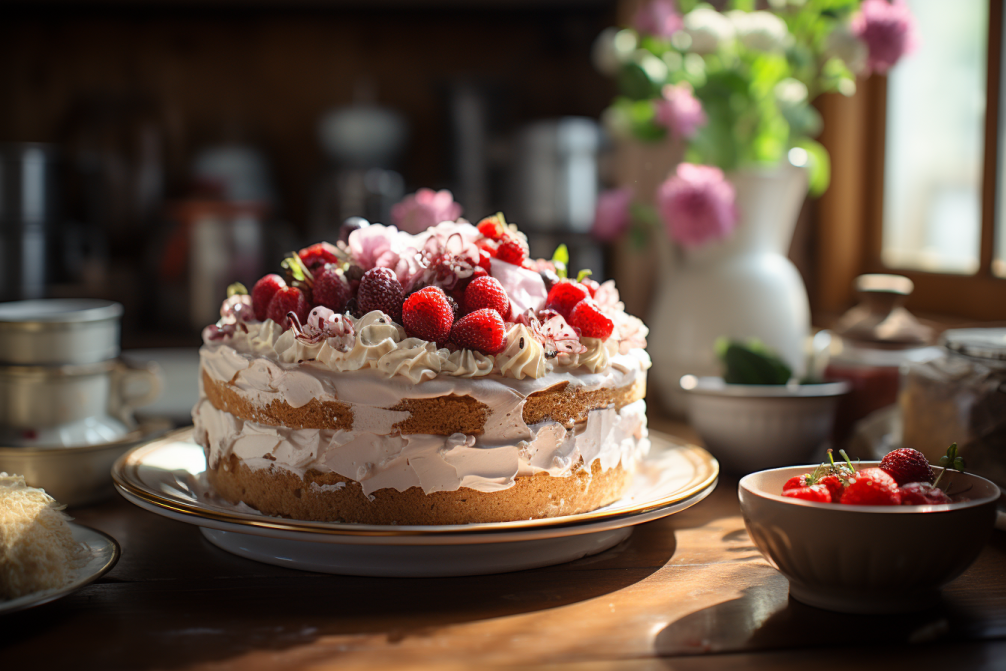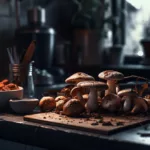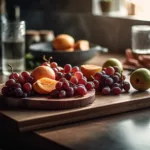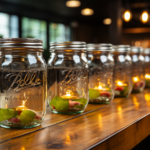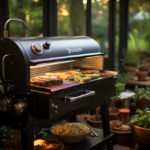Table of Contents
Unlocking the Delights of Baking: A Whisk in Time’s Expert Guide
Hey there, fellow baking enthusiasts! Are you ready to embark on a delicious adventure filled with beautiful aromas, delightful textures, and mouthwatering flavors? Look no further, because “A Whisk in Time: Guide to the Art of Baking” is here to whisk you away into the wonderful world of baking!
Whether you’re a seasoned baker or a total newbie, this guide is your ticket to unlocking the secrets and techniques of the baking realm. From the simplest cookies to the most decadent cakes, we’ve got you covered.
Join us as we dive deep into the essentials: choosing the right ingredients, mastering the perfect dough, understanding the science behind baking, and so much more. We’ll explore the importance of precise measurements, the magic of different leavening agents and thickeners, and how to troubleshoot common baking mishaps.
But this guide isn’t just about technical details! We understand that baking is an art form that allows you to express yourself and create edible masterpieces. That’s why we’ll also delve into the creative side of baking, exploring flavor combinations, decorating techniques, and innovative twists on classic recipes.
So grab your apron, dust off your trusty mixing bowls, and get ready to fill your kitchen with warmth, joy, and mouthwatering treats. A Whisk in Time: Guide to the Art of Baking” will be your faithful companion on this scrumptious journey. Let’s turn up the oven, and let the baking magic begin!
The Essential Aspects of Baking
Baking is a mix of science and art, a combination that delights both the palate and the senses. To truly excel in the art of baking, it’s crucial to understand and master the essential aspects that make up this delightful craft. In this guide, we’ll explore some key subheadings that will help you become a baking maestro:
Ingredients: The Foundation of Baking
- Flour: The backbone of most baked goods.
- Sugar: Adds sweetness and aids in browning.
- Eggs: Provide structure, moisture, and richness.
- Leaveners: Such as baking powder and baking soda, ensure a rise in baked treats.
- Fats: Like butter and oil, contribute to tenderness and flavor.
- Flavors: Extracts, spices, and aromatic additions give depth to your creations.
Mastering the Art of Dough
- Understanding the different types of dough: Pastry, bread, cookie, and cake dough all require different techniques.
- Kneading and resting: The secrets to achieving the perfect texture.
- Rolling and shaping: From perfectly round pie crusts to beautifully twisted bread rolls.
- Proofing and fermentation: Allowing yeast-based dough to rise and develop flavor.
The Science Behind Baking
- Understanding chemical reactions: How heat transforms ingredients and creates magic.
- Oven temperature and timing: The right balance to achieve golden perfection without burning.
- The role of leavening agents: How yeast, baking powder, and baking soda work their magic.
- Gluten development: The key to achieving light and fluffy results.
Troubleshooting Baking Mishaps
- Flat cookies and cakes: Pinpointing possible causes and solutions.
- Soggy crusts: Understanding how to prevent those dreaded soggy bottoms.
- Overly dense bakes: Tips to lighten up your creations without compromising flavor.
- Burned edges: How to prevent scorching while achieving a desirable brown crust.
By diving into these essential aspects of baking, you’ll gain the knowledge and confidence to create delectable treats that will impress your friends, family, and even yourself. So roll up your sleeves, preheat that oven, and let’s begin this sweet journey together!
Go-To Baking Tools: Must-Haves for Every Baker
Every baker needs a trusty set of tools to create magic in the kitchen. From measuring ingredients to achieving perfect textures, having the right equipment can make a world of difference. Here’s a list of essential baking tools to have on hand:
Investing in high-quality baking tools will elevate your baking experience and help you achieve professional results. So gather your essentials, equip your kitchen with these must-haves, and get ready to embark on a baking journey filled with delicious creations.
Choosing the Right Tools and Ingredients
When it comes to baking, the right tools and ingredients can make all the difference between a mediocre result and a truly mouthwatering masterpiece. Here are some essential aspects to consider when selecting your baking toolkit:
Quality Ingredients: The Secret to Outstanding Flavor
- Flour: Opt for high-quality all-purpose flour or specific types like cake flour for lighter textures.
- Sugar: Fine granulated sugar is a versatile option, but experiment with brown sugar or alternative sweeteners for unique flavors.
- Eggs: Fresh eggs are crucial for optimal flavor and texture. Look for organic or free-range options for even better results.
- Dairy: Opt for unsalted butter for better control over salt content. Full-fat dairy products offer richness and moisture.
- Flavorings: Invest in pure vanilla extract and experiment with other extracts like almond or citrus for delightful twists.
Essential Tools: Equipping Your Baking Wonderland
- Mixing Bowls: Choose a set in various sizes for mixing batters and doughs of different quantities.
- Measuring Cups and Spoons: Accurate measurements are key to consistent results. A digital scale is also handy for precise ingredient weighing.
- Whisk: A classic whisk helps incorporate air into batters, while a balloon whisk is perfect for beating egg whites and heavy creams.
- Spatulas: Rubber spatulas ensure no batter is left behind, and offset spatulas are excellent for spreading icing and smoothing surfaces.
- Baking Sheets: Opt for light-colored, non-stick baking sheets for even heat distribution and easy release of baked goods.
- Cooling Racks: Elevate your goodies on these wire racks to allow air circulation for faster cooling.
Remember that investing in good-quality tools and ingredients doesn’t have to break the bank. Start with the basics and gradually expand your collection as your skills grow.
By considering these essential aspects, you’ll have the foundation for baking success. So go ahead, stock your kitchen with delightful ingredients and reliable tools, and let the magic of baking begin!
Mixing and Measuring: The Foundations of Baking
In the wonderful world of baking, mastering the art of mixing and measuring is crucial for creating delectable treats that will wow your taste buds. Here are some essential aspects to consider when it comes to mixing and measuring in the kitchen:
Accurate Measurements, Tasty Results
- Use Measuring Cups: Invest in a set of measuring cups for dry ingredients like flour, sugar, and cocoa powder. Level off the ingredients with a straight-edge knife for precise measurements.
- Measuring Spoons: For smaller quantities of ingredients like baking powder, salt, and vanilla extract, use measuring spoons. These little tools ensure your ratios are spot-on.
- Scale: For the utmost precision, a digital kitchen scale is a game-changer. Weighing ingredients helps achieve consistent results, especially when working with ingredients like butter or chocolate.
Mixing Techniques for Optimal Texture
- Creaming Method: This technique involves beating butter and sugar together until light and fluffy. It’s perfect for creating airy cakes and cookies.
- Folding Technique: When incorporating delicate ingredients like whipped egg whites or flour into a batter, gently fold them in using a rubber spatula. This maintains the desired lightness.
- Beating Eggs: For recipes that require beating eggs, use a whisk or an electric mixer to whip them into a frothy consistency. This traps air and contributes to a lighter texture.
Understanding Mixing Order
- Dry Ingredients First: In most recipes, combining dry ingredients like flour, salt, and leaveners is the first step. This ensures even distribution when liquids are added.
- Butter/Batter Additions: Creaming butter with sugar comes next, followed by adding eggs and other wet ingredients. This helps create a smooth and emulsified batter.
- Alternate Dry and Wet Additions: When adding dry and wet ingredients to the batter, it’s best to alternate between them in stages. This prevents overmixing and ensures a uniform texture.
By paying attention to precise measurements and mixing techniques, you’re setting yourself up for baking success. So grab your measuring cups, unleash your creative instincts, and let the mixing magic whisk you away into a world of sensational flavors and textures!
Essential Baking Techniques Demystified
Baking is an art that requires a combination of skill, technique, and a pinch of creativity. To help you become a baking maestro, let’s demystify some essential techniques that will elevate your baked goods to new heights:
Creaming: Achieving Fluffy Goodness
- Start by beating butter and sugar together until light and fluffy.
- This technique creates tiny pockets of air, resulting in a soft and tender texture in cakes, cookies, and other baked treats.
Beating Egg Whites: Fluffy Clouds of Delight
- Separate the egg whites from the yolks and whisk them until they form stiff peaks.
- Beaten egg whites lend a light and airy texture to soufflés, meringues, and chiffon cakes.
Folding: Gentle Incorporation
- Use a rubber spatula to gently combine delicate ingredients, like whipped cream or beaten egg whites, into a batter.
- This technique keeps the mixture light and fluffy while avoiding overmixing, which could lead to a dense and heavy bake.
Brushing with Egg Wash: Golden Perfection
- Whisk an egg with a bit of water or milk, then brush it onto pastry dough or bread before baking.
- This creates a beautiful golden color and glossy finish, giving your bakes an irresistible appeal.
Blind Baking: For a Perfect Crust
- Pre-bake a pie crust before adding a wet filling to prevent it from becoming soggy.
- To blind bake, line the crust with parchment paper, fill it with pie weights or dried beans, and bake until golden brown.
Parchment Paper and Greasing: Easy Release
- Line baking pans with parchment paper for easy removal of cookies, cakes, and bread.
- Grease the pan or parchment paper with butter or cooking spray to ensure nothing sticks.
Mastering these essential baking techniques will add finesse and professionalism to your creations. So grab your whisk, gather your ingredients, and let your inner baking genius shine as you create mouthwatering delights that will leave everyone craving for more!
The Science Behind Baking: Understanding Leavening Agents
Baking is a delightful blend of art and science. To truly master the art of baking, it’s crucial to understand the science behind one of its key components: leavening agents. These magical ingredients help your baked goods rise to fluffy perfection. Let’s dive into the world of leavening agents:
Baking Powder: The Powerhouse
- Baking powder is a combination of baking soda, cream of tartar, and a dry acid like cornstarch.
- When combined with liquid and heat, baking powder releases carbon dioxide gas, causing the dough or batter to rise.
- It’s ideal for quick breads, muffins, pancakes, and cakes, where immediate rise is required.
Baking Soda: The Mighty Reactant
- Baking soda, also known as sodium bicarbonate, is an alkaline compound.
- When combined with an acidic ingredient like vinegar, lemon juice, or yogurt, it produces carbon dioxide gas.
- The carbon dioxide gas expands in the presence of heat, resulting in a light and airy texture.
- Baking soda works best in recipes with acidic ingredients or when an acidic component is added separately.
Yeast: The Fermentation Marvel
- Yeast is a microorganism that produces carbon dioxide through fermentation.
- It feeds on sugar and converts it into alcohol and carbon dioxide, which causes the dough to rise.
- Yeast is essential for bread-making, as it provides flavor and creates a delicate and chewy crumb.
Whipped Egg Whites: Airy and Fluffy
- Whipping egg whites creates an airy foam due to protein denaturation and the incorporation of air.
- This foam acts as a natural leavening agent, providing lightness and structure to cakes, mousses, and soufflés.
- The whipped egg whites help trapped air expand during baking, resulting in a light and fluffy texture.
Understanding the science behind these leavening agents allows you to make informed adjustments and achieve the desired texture in your baked goods. So go ahead, experiment with different leavening agents, and let the science of baking work its magical charm!
Perfecting the Art of Dough
Dough is the heart and soul of many baked goods. From flaky pastries to tender breads, mastering the art of dough is essential for creating irresistible treats. Let’s explore some key aspects to perfecting the art of dough:
Types of Dough: Knowing the Differences
- Pastry Dough: Tender and flaky, used for pies, tarts, and pastries.
- Bread Dough: Elastic and chewy, perfect for baguettes, rolls, and artisan breads.
- Cookie Dough: Versatile and easily customizable, ideal for cookies and bar desserts.
- Cake Batter: Light and fluffy, used for cakes, cupcakes, and muffins.
Kneading and Resting: The Secrets to Texture
- Kneading: Work the dough with the heels of your hands to develop gluten, which gives elasticity and structure.
- Resting: Allow the dough to rest and relax after kneading to enhance its texture and make it easier to work with.
Rolling and Shaping: Precision is Key
- Rolling: Use a lightly floured surface and a rolling pin to roll out dough to the desired thickness.
- Shaping: For bread dough, learn techniques like folding, rolling, or braiding to shape your loaves or specialty breads.
Proofing and Fermentation: Letting it Rise
- Proofing: Allowing yeast-based dough to rise in a warm, draft-free environment until it doubles in size.
- Fermentation: The process where yeast consumes sugar and releases carbon dioxide, resulting in a light and airy texture.
Remember to follow specific instructions for the type of dough you’re working with. Different doughs have different requirements, so be patient and enjoy the process of creating culinary wonders.
With practice, finesse, and a touch of creativity, you’ll soon be crafting stunning pastries, artisan loaves, and delectable treats that will impress friends and family alike. So grab your apron, gather your ingredients, and let the dough kneading begin!
Baking Your Way to Perfection: Troubleshooting Common Mishaps
Even the most experienced bakers encounter a few bumps along the sweet road to perfection. But fear not! With a little know-how and some troubleshooting magic, you’ll be able to overcome common baking mishaps like a pro. Let’s dive into some key solutions:
Flat Cookies and Cakes: Rise to the Occasion
- Check the leavening agents: Make sure your baking powder or soda is fresh and hasn’t expired.
- Don’t overmix the batter: Overmixing can lead to excessive gluten development, resulting in a dense texture. Mix until just combined.
- Check the oven temperature: An oven that’s too cool can cause cookies and cakes to spread instead of rise. Invest in an oven thermometer for accuracy.
Soggy Crusts: Battle the Sogginess
- Pre-bake the crust: For pie fillings that are juicy, blind baking the crust before adding the filling helps create a barrier and prevent sogginess.
- Drain excess moisture: If your filling is too wet, strain or pat dry any excess liquid before adding it to the crust.
Dense Bakes: Lighten Up the Mood
- Check the leavening agents: Ensure that your baking powder or soda is fresh and active.
- Don’t overmix the batter: Overmixing can lead to excess gluten formation and a dense texture. Mix until just combined.
- Incorporate more air: Beat butter and sugar longer during the creaming process to introduce more air into the batter.
Burned Edges: Protect the Perimeter
- Lower the oven temperature: If your baked goods consistently have burned edges, try reducing the temperature by 25 degrees Fahrenheit (about 15 degrees Celsius) and adjusting the baking time accordingly.
- Shield with foil: Towards the end of baking, tent the edges of your cakes, pies, or bread with foil to prevent further browning while allowing the center to finish baking.
Remember, baking is both an art and a science, and practice makes perfect. Don’t be discouraged by a few mishaps along the way; they’re just opportunities for learning and improvement. So grab your apron, embrace the challenges with a smile, and keep whisking your way to baking perfection!
The Sweet Symphony of Flavors: Exploring Taste Combinations
When it comes to baking, flavors are the heart and soul of every delicious creation. By mixing and matching different flavors, you can create extraordinary taste combinations that will leave your taste buds dancing. Let’s explore the art of flavor pairing:
Classic Combinations: Tried-and-True Winners
- Chocolate and Peanut Butter: The perfect marriage of rich cocoa and creamy nuttiness.
- Lemon and Blueberry: The tartness of lemon perfectly complements the sweetness of blueberries.
- Caramel and Sea Salt: The combination of sweet caramel and a touch of saltiness creates a heavenly balance.
Unexpected Twists: Pushing the Creative Boundaries
- Lavender and Honey: The floral notes of lavender blend seamlessly with the natural sweetness of honey for a unique and aromatic experience.
- Raspberry and Basil: The bright and tangy flavor of raspberry pairs surprisingly well with the fresh and herbaceous aroma of basil.
- Cardamom and Orange: The warm and spicy undertones of cardamom enhance the bright and citrusy flavors of orange.
Contrasting Textures: A Symphony of Mouthfeel
- Silky Custard and Crunchy Caramel: The luscious creaminess of custard against the crispy texture of caramel creates a delightful contrast.
- Velvety Mousse and Crumbly Graham Cracker Crust: The smooth and airy mousse combined with the crumbly crust offers a textural sensation.
Balancing Sweetness: A Journey of Flavor Harmony
- Sweet and Tangy: Pairing sweet fruits like strawberries or peaches with tangy ingredients like lemon or balsamic vinegar adds complexity and balance.
- Sweet and Salty: The combination of sweet and salty flavors, like adding a sprinkle of sea salt to caramel, creates a harmonious contrast that entices the taste buds.
With baking, the flavor possibilities are endless. Don’t be afraid to experiment, trust your instincts, and let your taste buds guide you. Go forth, embark on a flavor adventure, and create your own sweet symphony of tastes that will make every bite a memorable experience. Happy baking!
From Classic to Innovative: Reinventing Beloved Baking Recipes
In the world of baking, there’s always room for creativity and innovation. While classic recipes hold a special place in our hearts, adding modern twists can elevate them to new levels of deliciousness. Let’s explore how to reinvent beloved baking recipes:
Flavor Upgrades: Enhancing the Classics
- Infusing Flavors: Experiment with adding unique flavors to classic recipes. For example, try adding lavender to vanilla cake or cardamom to chocolate chip cookies. The possibilities are endless!
- Incorporating Spices: Spices like cinnamon, ginger, or nutmeg can add warmth and depth to traditional recipes. Consider adding them to pies, cakes, and even muffins for a delightful twist.
- Unique Extracts: Swap out traditional vanilla extract for different extracts like almond, coconut, or maple to bring a whole new dimension of flavor to your baked goods.
Texture Variations: Adding Excitement
- Nutty Crunch: Enhance the texture of your desserts by adding crushed nuts or toasted coconut to your crusts or fillings.
- Creamy Fillings: Consider incorporating velvety fillings like cheesecake or mousse to sandwiches, cookies, or pies to create indulgent and memorable treats.
- Caramelization: Transform classics like crème brûlée or tarts by caramelizing the tops with a blowtorch or under the broiler for an irresistible crust.
Creative Presentation: Stunning the Senses
- Deconstructed Treats: Disassemble traditional favorites like pies or cakes, and present them in unique ways. For example, serve mini pies in mason jars or create layered cake parfaits.
- Playful Shapes: Use cookie cutters to shape cookies or cake slices into whimsical forms, like animals or seasonal motifs, for an added touch of fun and artistry.
- Dessert Building Blocks: Experiment with combining different dessert components together, like a brownie crust with a cheesecake filling, or a pie crust with layers of different flavored mousses.
With a little imagination and a willingness to think outside the recipe box, you can breathe new life into traditional favorites. So unleash your inner baking genius, embrace experimentation, and embark on a journey of reinventing beloved recipes that will surprise and delight!
Decorating Like a Pro: Tips and Tricks for Showstopping Treats
The joy of baking goes beyond creating delicious treats – it’s an opportunity to let your creativity shine through dazzling decorations. With a few handy tips and tricks, you can take your baked goods from tasty to truly showstopping. Let’s dive into the world of decorating like a pro:
Frosting and Icing Techniques: The Finishing Touch
- Smooth Buttercream: Achieve a flawless finish by using an offset spatula and a bench scraper to smooth out the buttercream on cakes and cupcakes.
- Piping Perfection: Experiment with different piping tips to create decorative borders, rosettes, or intricate details on your treats.
- Royal Icing: Use royal icing for intricate designs and flooding cookies, creating beautifully detailed patterns.
Floral Flair: Edible Blooms
- Flower Power: Decorate your cakes and cupcakes with edible flowers, such as pansies or rose petals, for a touch of natural beauty.
- Buttercream Blooms: Learn how to pipe delicate buttercream flowers like roses, hydrangeas, or daisies to create stunning floral arrangements.
Creative Toppings and Garnishes: A Feast for the Eyes
- Chocolate Drizzles: Melt chocolate and drizzle it over your baked goods to add an elegant touch and create visual interest.
- Sprinkles and Edible Glitters: Add a whimsical touch by sprinkling colorful jimmies, nonpareils, or edible glitter on your treats for a playful and eye-catching look.
- Fresh Fruits: Top your creations with fresh, seasonal fruits like berries or slices of citrus to add a burst of color and a refreshing touch.
Finishing Touches: Accents and Detailing
- Stencils and Designs: Use stencils to create intricate patterns on cakes, cookies, or cupcakes by dusting cocoa powder, powdered sugar, or colored sprinkles over them.
- Edible Paint and Metallics: Add a touch of luxury by using edible metallic paints or gold leaf to create a striking and glamorous look.
- Personalized Messages: Write heartfelt messages or names on cakes or cookies using a piping bag filled with melted chocolate or royal icing.
Remember, practice makes perfect. Don’t be discouraged if your first attempts aren’t flawless – decorating is all about honing your skills and having fun. So grab your piping bags, sprinkle on some creativity, and let your creations become edible works of art that will amaze and delight!
Baking for Special Diets: Gluten-Free, Vegan, and More
Baking is all about spreading joy and treating everyone to delicious treats. Fortunately, there are plenty of options available for those with special dietary needs or preferences. Whether you’re baking for someone who’s gluten-free, vegan, or has other dietary restrictions, here are some tips and tricks to make sure everyone can enjoy your baked creations:
Gluten-Free Baking: No Gluten, No Problem
- Gluten-Free Flour Blends: Use pre-made gluten-free flour blends, or create your own mix using a combination of flours like almond, rice, and tapioca flour.
- Xanthan Gum: Add xanthan gum to gluten-free recipes to mimic the binding properties of gluten and prevent a crumbly texture.
- Experiment and Adapt: Be prepared for some trial and error as you adapt your favorite recipes. Find the right balance of gluten-free ingredients and techniques.
Vegan Baking: Plant-Based Delights
- Substituting Eggs: Replace eggs with alternatives like applesauce, mashed bananas, tofu, or flaxseed meal mixed with water.
- Plant-Based Milk: Substitute cow’s milk with almond milk, soy milk, or oat milk to achieve a vegan-friendly result.
- Vegan Butter and Margarine: Swap dairy butter with vegan butters or margarines to achieve the desired texture in your baked goods.
Allergies and Intolerances: Catering to Individual Needs
- Nuts and Nut-Free Options: Consider nut allergies by using alternatives like seeds, sunflower butter, or tahini in your recipes.
- Dairy-Free Choices: Avoid dairy with plant-based milk, coconut cream, or dairy-free alternatives like vegan cream cheese or yogurt.
- Gluten-Free and Vegan: Combine gluten-free and vegan techniques to cater to those with multiple dietary restrictions.
Labeling and Cross-Contamination: Safety First
- Clearly label your baked goods to indicate any potential allergens or dietary restrictions.
- Prevent cross-contamination by thoroughly cleaning surfaces, utensils, and equipment, especially when switching between regular and specialty ingredients.
Remember, baking for special diets may require some adjustments, but it doesn’t mean sacrificing taste or creativity. Embrace the challenge, experiment with new ingredients, and open the doors to a wider array of delightful treats that everyone can enjoy!
Sharing the Love: The Joy of Sharing Baked Goods with Others
One of the most wonderful aspects of baking is the joy of sharing your creations with others. Whether it’s surprising a friend with a batch of warm cookies or bringing a homemade pie to a family gathering, the act of giving homemade treats is a heartfelt gesture that spreads happiness and creates lasting memories. Here’s why sharing your baked goods brings such joy:
Creating Connections: A Delicious Bond
- Sharing homemade treats creates a sense of connection and warmth between you and the recipient. It’s a thoughtful gesture that shows you care.
- The act of sharing fosters conversations and brings people together. It provides an opportunity to connect with others over a shared love of baked goods and delightful flavors.
Sweet Surprises: Spreading Smiles
- Surprising someone with a fresh batch of baked goods brings instant delight and puts a smile on their face. It’s a small gesture that can brighten someone’s day.
- From birthdays to holidays, baking for special occasions allows you to create memories and traditions. Your treats become a symbol of celebration and joy.
Expressing Creativity: Edible Works of Art
- Sharing your baked creations allows you to express your creativity and artistry. Each dessert is a unique masterpiece crafted with love and passion.
- It’s a way to showcase your baking skills and delight others with your culinary talents. Sharing your creations lets your creativity shine.
Spreading Happiness: The Gift of Goodness
- Food has the power to evoke happiness and comfort. By sharing your baked goods, you’re sharing happiness and bringing moments of joy to others.
- Homemade treats have a personal touch and a taste that store-bought items simply can’t replicate. They’re a heartfelt gift that shows you’ve put time and care into making something special.
So, don’t hesitate to share your baked goods with others. Whether it’s a small gesture of appreciation or a grand display of culinary prowess, the act of giving homemade treats brings people closer, spreads happiness, and creates priceless memories. Share the love, one delicious bite at a time!
Baking as an Expression of Creativity: Finding Your Unique Style
Baking is not just about following recipes; it’s a form of creative expression that allows you to put your own unique spin on sweet creations. Discovering your baking style and developing your own signature touch can make the experience even more fulfilling. Here are some tips to help you find your own unique baking style:
Experiment and Explore: Get Creative in the Kitchen
- Don’t be afraid to step outside your comfort zone. Experiment with flavors, techniques, and ingredients to create something entirely new.
- Look for inspiration in unexpected places – nature, artwork, or even your favorite books or movies can spark fresh ideas for flavor combinations and designs.
- Embrace improvisation. Sometimes the best creations are the result of a happy accident or a last-minute substitution.
Personalize with Flair: Make It Your Own
- Put your own twist on classic recipes. Add a unique ingredient, switch up the flavors, or experiment with different textures to make it truly your own.
- Create custom decorations. Use your artistic talents to design your own cake toppers, edible flowers, or intricate piping patterns.
- Incorporate family traditions or cultural influences into your baking. Use cherished family recipes or draw inspiration from traditional sweets to infuse your creations with sentimental value.
Presentation and Styling: Let Your Creations Shine
- Pay attention to the visual aspect. Experiment with different plating styles, garnishes, and serving suggestions to elevate your desserts and create stunning presentations.
- Play with colors and textures. Use a variety of vibrant hues and contrasting elements to make your treats visually stunning and eye-catching.
- Invest in quality baking tools and equipment. Having the right tools can help you achieve the desired textures, shapes, and finishes that match your unique style.
Share and Celebrate: Spread the Joy
- Share your creations with others. Baking is meant to be enjoyed and appreciated by others, so let your friends and family taste your delicious triumphs.
- Participate in baking challenges or competitions. They can provide a platform to showcase your skills, gain inspiration from others, and grow as a baker.
- Celebrate your own achievements, no matter how small. Every time you bake something that reflects your creativity, take a moment to acknowledge and be proud of your own unique style.
Remember, finding your unique baking style is a journey of self-discovery and exploration. Don’t be afraid to push boundaries, trust your instincts, and let your creativity guide you. So roll up your sleeves, grab your mixer, and embark on a baking adventure that is truly your own.
Time-Saving Hacks for Busy Bakers
In today’s fast-paced world, finding time for baking can be a challenge. Luckily, there are many time-saving hacks and strategies that can help you indulge in your love for baking even when you have a packed schedule. Here are some tips to help busy bakers make the most of their precious time:
Plan Ahead: Be Prepared
- Make a baking schedule or plan. Set aside specific dedicated baking times in your week or weekends.
- Choose recipes wisely. Opt for quick and easy recipes, like cookies or muffins, that require minimal prep and baking time.
- Create a shopping list. Plan your ingredients ahead of time to minimize trips to the grocery store.
- Batch Baking: Doubling the Fun
- Double or triple recipe quantities. When you’re already in baking mode, make an extra batch to freeze or share with others.
- Utilize your oven’s capacity. Bake multiple items simultaneously, like cookies on one tray and muffins on another, to save time and energy.
Prep in Advance: Ready, Set, Bake
- Pre-measure ingredients. Prepare your dry and wet ingredients separately and store them in labeled containers until you’re ready to mix them together.
- Use ready-made mixes or shortcuts. Embrace pre-made dough, cake mixes, or pre-cut pie crusts to save time without compromising on taste.
Smart Kitchen Organization: Efficiency is Key
- Keep essential tools easily accessible. Organize your kitchen so that baking essentials like measuring cups, spatulas, and mixing bowls are within reach.
- Clean as you go. Wash dishes, wipe down counters, and clean as you wait for things to bake. This ensures less time spent on cleanup later.
Freezing and Storage: Bake Now, Enjoy Later
- Freeze cookie dough and pie crusts. Portion out dough into individual servings and freeze for future use.
- Store baked goods properly. Wrap or place your baked treats in airtight containers to keep them fresh for longer and enjoy them over time.
Remember, baking is meant to be enjoyed, so don’t stress about time constraints. Embrace these time-saving hacks, find moments in your schedule for baking, and indulge in the pleasure of creating delicious treats. With a little planning and organization, you can savor the joy of baking even when life gets busy.
Beyond Desserts: The Versatility of Baking in Savory Delights
While baking is often associated with sweet treats, its versatility extends far beyond the realm of desserts. Baking can be a wonderful technique for creating savory dishes that are both comforting and delicious. Let’s explore the endless possibilities of baking in savory delights:
Breads and Rolls: The Pillars of Savory Delights
- Soft Rolls and Baguettes: Bake your own homemade bread to accompany a hearty soup or serve as the foundation for sandwiches.
- Flaky Biscuits: Perfect for breakfast sandwiches, paired with a bowl of chili, or simply enjoyed with a smear of butter.
Roasted and Baked Vegetables: Enhancing Natural Flavors
- Roasted Root Vegetables: Toss vegetables like carrots, parsnips, and potatoes with olive oil and seasonings, then roast them until tender and caramelized.
- Stuffed Bell Peppers: Fill bell peppers with a mixture of rice, cheese, and your favorite vegetables, then bake until the peppers are soft and the filling is hot and melty.
Savory Pies and Quiches: Wholesome and Flavorful
- Quiche Lorraine: A classic combination of eggs, bacon, cheese, and cream baked into a buttery crust. Perfect for brunch or a light lunch.
- Chicken Pot Pie: Create a rich, creamy filling of chicken and vegetables, encased in a flaky pastry crust for a comforting dinner.
Savory Tarts and Galettes: Rustic Elegance
- Tomato and Basil Galette: Layer ripe tomatoes, fresh basil, and mozzarella cheese on a pastry crust, then bake for a vibrant and flavorful appetizer or light meal.
- Caramelized Onion and Gruyère Tart: Create a flavor-packed combination of sweet caramelized onions and nutty cheese on a crispy tart base.
Savory Pastry Pockets: Portable Gourmet Delights
- Hand Pies: Fill pockets of flaky pastry with delicious combinations like spinach and feta, or chicken and mushroom, for a delightful grab-and-go meal.
- Empanadas: Bake savory turnovers filled with seasoned meats, vegetables, and spices, for a taste of Latin American cuisine.
Baking savory delights allows for creativity and exploration in the kitchen. Whether you’re looking to spice up your weekday dinner or impress guests at a gathering, the world of savory baking offers a wide range of possibilities. So switch up your baking routine, embrace the savory side, and let your oven work its magic to create delicious and wholesome savory delights.
Get ready to roll up your sleeves and dive into the wonderful world of sugary wonders and delectable treats – it’s going to be a deliciously inspiring journey!
Get Ready for a Deliciously Inspiring Journey!
Baking is a magical adventure that combines science, art, and a whole lot of love. It’s time to dust off your apron, gather your ingredients, and get ready to roll up your sleeves as we embark on a tantalizing journey into the wonderful world of sugary wonders and delectable treats.
Discovering the Basics: We’ll start by exploring the essential techniques and ingredients that form the foundation of baking. From measuring and mixing to understanding the role of leavening agents, we’ll demystify the essentials and set you up for baking success.
Unleashing Your Creativity: Baking is not just about following recipes; it’s an opportunity to let your creativity shine. We’ll delve into flavor pairings, innovative twists on classic recipes, and decorative techniques that will help you develop your own unique style. Your kitchen will transform into a canvas for edible masterpieces.
Overcoming Challenges with Ease: Baking has its fair share of challenges, but fear not! We’ll tackle common mishaps head-on with troubleshooting tips and clever hacks to ensure that every bake turns out just right. From flat cookies to burned edges, you’ll be equipped with the knowledge to conquer any baking obstacle.
Beyond Desserts: While desserts often steal the spotlight, we’ll also explore the versatility of baking in savory delights. From homemade bread and roasted vegetables to quiches and tarts, we’ll broaden our horizons and discover the savory side of baking that will have taste buds dancing with delight.
Sharing the Love: Baking is not only about indulging yourself; it’s about spreading joy and creating heartwarming moments. We’ll discover the joy of sharing baked goods with others, whether it’s surprising a friend with a batch of warm cookies or bringing homemade treats to special occasions. The act of giving and sharing will enhance the sweetness of your creations.
Are you ready to whip up buttery pastries, create beautifully decorated cakes, and fill your kitchen with irresistible aromas? Great! Strap on your apron, grab your whisk, and get ready for a whisk in time like no other. Let the baking adventure begin!
Conclusion
In conclusion, “A Whisk in Time: Guide to the Art of Baking” is your passport to a delectable journey filled with tantalizing aromas, mouthwatering flavors, and unforgettable creations. Whether you’re a seasoned baker or a novice in the kitchen, this guide provides the essential knowledge, tips, and tricks to help you become a baking maestro.
From mastering the fundamentals of measuring and mixing to exploring the endless possibilities of flavor combinations and decorative techniques, this guide has you covered. It empowers you to unleash your creativity, experiment with unique twists on classic recipes, and develop your own signature style.
But baking is not just about the end result – it’s a labor of love that brings people together. The joy of sharing your creations with others, whether it’s through surprising gestures or celebrating special occasions, adds an extra layer of sweetness to the experience.
So, grab your whisk, tie on your apron, and let the aroma of freshly baked treats fill your kitchen. With “A Whisk in Time: Guide to the Art of Baking” as your faithful companion, you’ll be equipped with the knowledge and inspiration to create amazing edible masterpieces that will delight the senses and create cherished memories. Happy baking!

